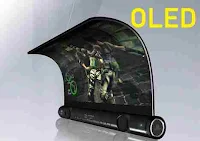In this article, we provided the best seminar reports and ppt on the topic Organic Light Emitting Diode (OLED). Study the working principle, basic structure, fabrication methods and future of Organic Light Emitting Diode (OLED).
How they work, What they are made of, different strategies to manufacture them with layers thicknesses, and the many applications for them. An OLED is a device that emits light under the application of an external voltage. By definition, an OLED (organic light-emitting diode) is a light-emitting diode (LED) in which the emissive electroluminescent layer is a film of organic compound which emits light in response to an electric current. This layer of organic semiconductor is situated between two electrodes. There are two main classes of OLED devices: those made with small organic molecules and those made with organic polymers. OLEDs have the unique properties of lightweight, flexible, transparent, and color tuneability, which makes them an ideal modern light source.
How they work, What they are made of, different strategies to manufacture them with layers thicknesses, and the many applications for them. An OLED is a device that emits light under the application of an external voltage. By definition, an OLED (organic light-emitting diode) is a light-emitting diode (LED) in which the emissive electroluminescent layer is a film of organic compound which emits light in response to an electric current. This layer of organic semiconductor is situated between two electrodes. There are two main classes of OLED devices: those made with small organic molecules and those made with organic polymers. OLEDs have the unique properties of lightweight, flexible, transparent, and color tuneability, which makes them an ideal modern light source.
The substrate is used to support the OLED. The substrate most commonly used may be plastic, foil, or even glass. The anode component usually used is indium tin oxide ITO. Usually, metals like barium, calcium, and aluminum are used as a cathode. The commonly used electrons transport layer components are PBD, Alq3, TPBI, and BCP.
Some of its major applications are as follows:
- Passive-matrix OLED (PMOLED) displays are usually small (up to 3" typically) and are being used in MP3 players, mobile phone sub-displays, etc.
- The best uses for Active-matrix OLED (AMOLED)s are computer monitors, large-screen TVs, and electronic signs or billboards.
- Transparent OLED (TOLED) device has a good contrast even in bright sunlight so it is applicable in head-up displays, laptops, mobile phones, and smart windows.
- Top-emitting OLED is used in displays in smart cards.
- Foldable OLED is used in GPS devices, cell phones, and large curved screen TVs.
- White and other colors OLED are used in car lighting and flat lamps.


0 comments